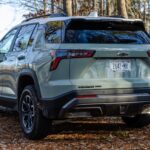The Hellcat engine. Just the name evokes images of raw power and unparalleled performance. For enthusiasts looking to maximize horsepower, especially in vehicles like the Jeep Grand Cherokee Trackhawk (the “Hellcat Jeep”), understanding the engineering behind this legendary engine is crucial. Mopar didn’t just bolt on a supercharger; they designed the engine around it, creating a platform that’s both robust and incredibly potent.
One critical aspect of Mopar’s approach is how they’ve integrated the supercharger system. Unlike some manufacturers who treat supercharging as an afterthought, bolting pulleys and belts onto existing engines in a way that can induce stress, Mopar prioritized a cohesive design from the outset. They positioned the supercharger pulley as close to the crankshaft as possible while maintaining stock accessory spacing. This seemingly small detail has a significant impact, drastically reducing stress on the front main bearing. For anyone considering supercharger upgrades, especially on a platform intended for high performance like a “Hellcat Jeep” or similar builds, this design philosophy is a game changer.
This integrated approach extends to component choices. When modifying a non-Hellcat car and aiming for serious power with a supercharger kit, the smart move is to first convert to genuine Hellcat accessories. Then, select a Hellcat-compatible supercharger kit from aftermarket companies. Mopar has laid the groundwork perfectly, creating a robust foundation upon which to build even more extreme power. This foresight allows aftermarket blowers to perform at their absolute best without compromising the engine’s structural integrity.
A standout feature of the Hellcat supercharger system is the clutched pulley. This ingenious design is likely a major contributor to Mopar’s ability to confidently warranty these high-performance vehicles. Think about belt longevity: in many supercharged setups, belt slap – the rapid deceleration of the supercharger when the throttle is lifted – is a major cause of belt wear and failure. At high engine RPMs, a supercharger spins at multiples of that speed. Sudden deceleration can put immense stress on the belt. The Hellcat’s clutched pulley cleverly mitigates this by allowing the supercharger to freewheel during deceleration, virtually eliminating belt slap. This, alongside features like clutched alternator pulleys now common in performance engines, showcases Mopar’s commitment to durability and reliability even at extreme power levels.
In conclusion, for those seeking “Hellcat Jeep” level performance or undertaking performance builds, the lessons from Mopar’s Hellcat engine design are invaluable. Their integrated approach, particularly the strategically placed supercharger pulley and the innovative clutched pulley, demonstrates a superior engineering philosophy. By prioritizing robust design and component integration, Mopar has not only created a powerhouse engine but also a blueprint for reliable, high-performance supercharging that enthusiasts can leverage for their own projects.

